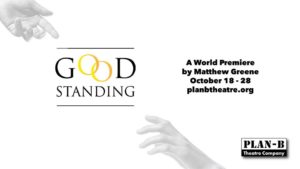
Matthew Greene won the 2018 AML Drama Award for
Good Standing, which was produced by Plan-B Theatre Company in Salt Lake City, October 2018, and New York City, November 2018. Janine Sobeck Knighton, an Assistant Professor of New Work (Playwriting, Screenwriting, and Dramaturgy) at Utah Valley University conducted this interview. Thank you to Matthew and Janine!
How did you originally get into playwrighting?
I grew up wanting to be a musical theatre actor, actually. As I lived my teenage-drama-nerd life and transitioned to college at BYU it became pretty clear I didn’t want to pursue professional acting and I started to think about other avenues I could go down. But the idea to explore playwriting didn’t come until I was serving a mission in Brazil. Partly thanks to a companion who was an aspiring screenwriter I started to realize I saw the world in terms of stories. I enrolled in a playwriting course my first semester back and met Eric Samuelsen, who truly changed my life. He saw something in me and my early work and, essentially, sat me down and said, “I think you could actually do this.” I was still a really active member of the LDS church at the time and those hours spent locked in my room with a play-in-progress became my “safe space,” an opportunity to explore sticky issues and navigate grey areas in a very black-and-white world. Playwriting felt like a natural fit and, to be honest, became my salvation.
What’s your favorite thing about writing a new play?
There’s a magical moment when things click, when all the messy ideas I’ve been exploring through freewriting and researching and pacing around talking to myself finally come into focus together. It’s the moment when I think: “There it is.” I can viscerally remember when and where a lot of these realizations happened because it’s such a transcendent experience. It happens for about one-in-ten ideas I have (maybe less often than that) but that’s when I know something is really worth pursuing. Sometimes it happens while I’m walking home, sometimes in the shower, sometimes in a dream in the middle of the night. If I could figure out how to manufacture and control it, I’d be much more efficient, I’m sure. But there’s no magic in that…
Could you tell us a little bit about your process as a playwright?
Beyond the “magic moment” experiences detailed above, I’m pretty scientific and analytical about the process. I do a lot of reading and research so I have a full toolbox at my disposal. I freewrite in those black composition notebooks until I feel like I have enough to build upon. (There’s something kinetic about the pen-to-paper feel; I can’t freewrite or brainstorm on a computer.) Then I bust out the index cards and storyboard the hell out of the script. This structure will inevitably change and evolve, but without it I can’t free myself up to write dialogue. I tend to write the actual text of a play lying down, because that’s how Stephen Sondheim writes. And I talk to myself a LOT. When I have a draft I feel okay with, I’ll have some friends read it aloud, have a mini-anxiety-attack, and start a rewrite a week or two later, once I’ve cleared my head. I’ll repeat most of the process all over again for each major rewrite. And, of course, I’m always working on several things at a time so I can be using my “idea brain” for something, my “research brain” for something else, my “dialogue brain” and “rewrite brain” for others, and so on.
 Where did the idea for Good Standing come from?
Where did the idea for Good Standing come from?The short answer: it came from being an angry and heartbroken gay Mormon. The longer answer, though, is that I was deeply, deeply troubled by the “exclusion policy” the church adopted in 2015. It felt like it created a chasm between me and some of the people I love most in this world, a chasm none of us wanted or asked for. I’ve never asked my friends or family to stop believing what they believe, even as my own beliefs have evolved. It was painful, though, to see structures being put in place that seemed designed to create more division among people who love and value each other. Simultaneously, I realized I’d made villains of nameless, faceless church leaders and members who I believed were behind this change; I’d been hurt and, in order to survive, had dehumanized those who had hurt me. By the time I started writing Good Standing, I realized it was time to move on and to heal and, as I’ve known since I started writing, I knew dramatizing these events and ideas would be the best way to work through it all.
What drew you to write it as a one-person show instead of having different actors in all the roles?
While, on the surface, the story of Good Standing focuses on the varied responses to Curtis’s disciplinary council, the real journey we’re following is the opposite: Curtis is trying to understand these men who are tasked with “passing judgment” on him. By the end of the play, he has stepped into their shoes and explored what they are feeling and dealing with. It isn’t all pretty or easy, but every one of these fifteen men is a human being who feels justified in his actions and beliefs, sure that he’s doing the right thing. It was important for me to have this realization about people with whom I disagree deeply and it became equally important for Curtis to go through this as well. So, the best way to physicalize the thematic content was to present it as a solo show.
What intrigued you the most about the reception of the play during its production at Plan B in Salt Lake City?
It’s such a quiet, unassuming play, something that a lesser actor or director would have treated with distrust. What Jerry and Austin helped me to see, though, is that if we trusted the text and the journey, it would work. (In many ways it was good I wasn’t present for the whole rehearsal process because I have a tough time trusting myself as deeply as they did.) I’m always blown away when something I write can connect with an audience member on a personal level; this play really seemed to touch a nerve with a lot of people and it was humbling to see that happen. I believe that’s what theatre is for: to make us all feel seen.
Based on your experience writing the play, what have been your thoughts about the recent LGBTQ policy changes by the Church of Jesus Christ of Latter-day Saints?
I support any policy change in this or any organization that represents a step toward compassion, reconciliation, and understanding. That being said, though, it’s just a step and I hope there’s more positive change to come. This policy caused a lot of pain, a lot of division, and if church leadership is committed to ameliorating that, I applaud them for it. Again, it’s one step in a long journey, but I’m happy to see what looks like positive change in the lives of so many people I love. The elephant in the room: I don’t think it’s enough. The higher power I know and believe in has a plan of happiness for everyone. I still feel like the church doesn’t have a doctrinal answer for queer folks (or for other marginalized groups) so I’m seeking truth elsewhere. Still, I’m happy to see healing happen and hope the progress continues!
Can you tell us anything about current or upcoming projects?
I’ve got a few exciting workshops/labs coming up in New York and am working on a couple of new musicals I’m excited about. It’s a pretty big shift away from such a small, intimate production like Good Standing but I’m always up for a challenge.
AML Award Citation:
Good Standing tells the story of a disciplinary council by the Church of Jesus Christ of Latter-day Saints for a member who chosen a same-sex marriage. A one man show, the script masterfully weaves through the different experiences and perspectives of the member and the 15 men sitting on the council.
With such a current hot button topic, it would have been easy for such a story to fall into the pitfalls of being either incredibly preachy or political. However, by giving dimension and depth to each of the characters, Greene effectively explores this very complicated situation from a multitude of angles. Readers and viewers easily find points of view that they agree with along with points of view that open their eyes to a new perspective. Perhaps the most appreciated part is that everyone in the script, no matter their viewpoint, is treated with compassion. Good Standing is a thoughtful work that encourages all who interact with it to literally stand in the shoes of their neighbor.
Matthew Greene’s play
Adam and Steve and the Empty Sea was named “Best Original Play” by the 2013 Salt Lake City Arty Awards. His other plays include
Job Well Done (national finalist, American College Theatre Festival),
Bread of Affliction (Society for the Study of Jewish American and Holocaust Literature) and
#Mormoninchief (New York International Fringe Festival). His film
Boy With Blue was awarded Best of Fest at the Oceanside Film Festival. His 2016 play
Gregorian was an AML Award finalist. He currently works as a teaching artist with Opening Act, an organization that provides theatre education to underserves high schools. A California native, Matthew earned a B.A. in Theatre at Brigham Young University and currently lives in New York City.
Janine Sobeck Knighton is an Assistant Professor of Playwriting, Screenwriting, and New Work Development at Utah Valley University. Other gigs have included Dramaturgy Specialist at Brigham Young University and Artistic Associate: Literary at Arena Stage (Washington, D.C.). Other artistic adventures have included being a member of the Artistic Council for the Eugene O’Neill Theater Center, a Reader for the Sundance Theatre Lab, a member of the Plan-B Theatre Lab and a Developer of the New Play Exchange for the National New Play Network. She is a former Executive Board member of Literary Managers and Dramaturgs of the Americas.
 Matthew Greene won the 2018 AML Drama Award for Good Standing, which was produced by Plan-B Theatre Company in Salt Lake City, October 2018, and New York City, November 2018. Janine Sobeck Knighton, an Assistant Professor of New Work (Playwriting, Screenwriting, and Dramaturgy) at Utah Valley University conducted this interview. Thank you to Matthew and Janine!
Matthew Greene won the 2018 AML Drama Award for Good Standing, which was produced by Plan-B Theatre Company in Salt Lake City, October 2018, and New York City, November 2018. Janine Sobeck Knighton, an Assistant Professor of New Work (Playwriting, Screenwriting, and Dramaturgy) at Utah Valley University conducted this interview. Thank you to Matthew and Janine!
